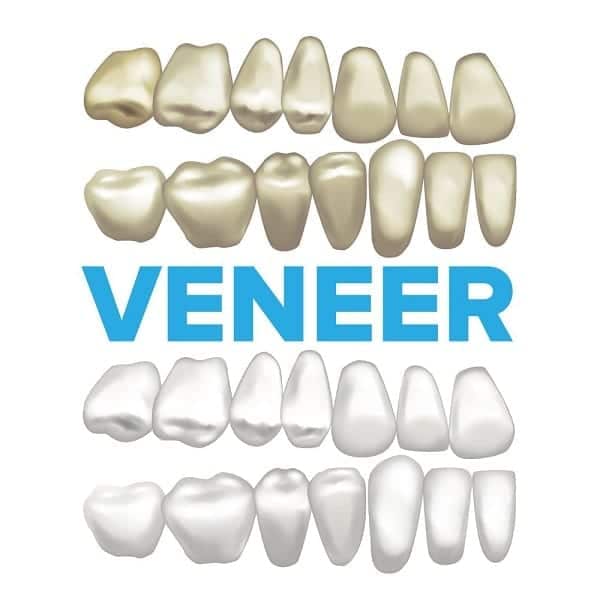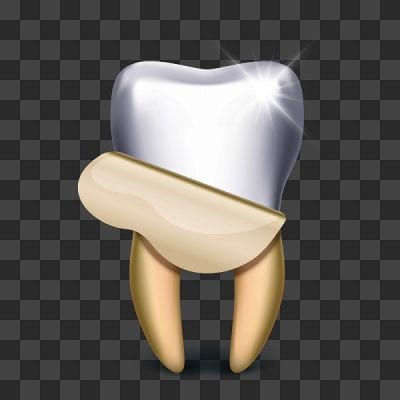A dental veneer is a type of dental prosthetic and cosmetic repair system that’s similar to crowns and fillings. Unlike the latter, a dental veneer involves the use of thin porcelain shells or composite resin material that are customized or tailor-fitted for placement over your teeth (usually the front ones like incisors and canines). The molars are best replaced outright with crowns due to the strength of bite forces from that portion of your mouth and jaw. A veneer is usually used on front teeth because a series of porcelain shells is usually enough to improve front teeth quality.
There are two types of veneers: composite or ceramic and porcelain. Here’s what you need to know about them: Porcelain uses material that’s smooth and appears as natural as your teeth, but it requires a lot of milling in order to come out as natural. On the other hand, ceramic veneers are easier to make and cost less, but their surface get more easily stained compared to their tougher and smoother porcelain counterpart.
Page Contents
Why Should You Use Veneers?

If you want to create a mostly pleasing and durable smile out of your teeth that are misshapen, chipped, and/or discolored, then veneers are the way to go. This is especially true if you wish to have a natural smile instead of one that looks fake and unnaturally straight, since each veneer is designed with the underlying tooth in mind. It also helps that veneers are more difficult to stain yellow than regular teeth since they’re made of porcelain, thus making them one of the ultimate ways to achieve the brightest smile possible.
This is because the dental veneer is a thin wafer or shell of tooth-colored porcelain. It’s placed via cement unto the front surface of natural teeth, covering their imperfections through a facade. This is as opposed to the more expensive crown that requires you to shave off your imperfect teeth so that you can plug and cement a crown on top of the visible teeth above your gumline. It’s a straightforward method of solving various physical and aesthetic issues immediately.
Veneers are not temporary, removable false teeth or crowns. Once you put them on they’re permanently attached to your teeth. What’s more, when getting them you need to cooperate with your dentist in order to determine if veneers are the best course of action for your needs.
What Can Veneers Do and Not Do?
You need to weigh their pros and cons first to make that informed decision of getting them or not. Veneers are capable of accomplishing many things, which includes the following.
- Fix gaps.
- Repair a chipped tooth.
- Cover stains on the tooth.
- Change the shape of a tooth.
- Straighten out crooked teeth.
- Alter broken or chipped teeth.
- Color-correct yellow teeth for a whiter smile.
- Make your smile more aesthetically pleasing.
- Treating teeth with enamel erosion or abrasion.
In regards to the shortcomings or disadvantages of putting on porcelain veneers, they include the following. Usually, it involves whether or not your teeth are strong enough to hold the shell.
- The tooth should have loads of enamel.
- They cannot be easily repaired when broken.
- Veneers cannot fix severely misaligned or crooked teeth.
- You can’t use veneers on a tooth with a missing piece or filing.
- Porcelain veneers are more expensive than their composite counterparts.
- It takes more time and attention to detail to make a proper porcelain veneer.
- You can only use them on strong and healthy teeth with no previous bonding.
As for the aftercare concerns, keep in mind the following things.
- Avoid full-contact sport activities.
- Don’t bite your fingernails or grind your teeth.
- Don’t eat things like hard candy, nuts, chips, and toast.
- Chop up any hard foods like pieces of chocolate, pears, and apples.
Expectations and Realities of Using Veneers

Additionally, veneers feature the following important aspects and expectations. Let’s delve deeper on what you can expect or get out of such a procedure in the first place.
- Easily Whiten Your Smile in a Snap: After years of eating highly pigmented foods, smoking cigarettes, or drinking coffee, your teeth will get stained yellow or brown. The food you eat will take their toll on your dental coloration. If your teeth have an unattractive shade of brown or yellow, you can have the stained enamel bleached at home or at the dentist chair. However, they will get stained again over time. If you want an easier method of keeping them as white as possible permanently, then putting on veneers might be the correct solution when push comes to shove.
- Stain Resistance from Porcelain Hardware: According to the NIH (National Institute of Health), porcelain veneers in particularly are known for their stain resistance. Composite or ceramic veneers, not so much but they’re much cheaper because of it. By availing or porcelain shells cemented over your natural teeth, you’ll be able to stave off dental discoloration and keep your pearly whites as pearly and as white as the teeth of famous celebrities.
- Fix Minor Cosmetic Problems: Veneers are also dependable when it comes to fixing minor cosmetic problems like gap tooth or crooked teeth. It shouldn’t be too major of a problem though, such as fixing an underbite or overbite; those require something more drastic, like getting orthodontic braces involved. Actually orthodontics can treat gapped or crooked teeth fine, but according to Dentistry Today, you have the choice to use veneers to hide or fix such issues if they’re only minor issues.
- Camouflage Minor Orthodontic Problems: Veneers are attached on the front part of your teeth, so you can’t change the position of the natural teeth to fix them. Instead, they cover them up or camouflage any slight imperfections after their application. Their appeal comes from the fact that your minor teeth need not be shaved down to a tiny stump to serve as abutment for a crown or a bridge. You can save the underlying tooth by giving it a better front-facing veneer or prosthetic enamel.
- Each Shell Protects Each Individual Tooth: Your teeth will sill be crooked or gapped after applying the veneer, but no one will know from your smile except you and the dentist who applied the veneer. It’s better than a jacket because each shell protects and improves each individual tooth. It’s better than a crown because you don’t need to plug a whole crown over the tooth. However, a veneer is no replacement for braces. Your dentist might refer you to an orthodontist instead if veneers are inadequate for your needs.
- Replace Damaged Enamel: Despite its strength, enamel or the tooth’s outer shell isn’t indestructible. Things like hard brushing or acidic foods and beverages can wear it down. Acid reflux disease can damage it as well. A sugary or starchy diet can also result in bacterial infection that wears down on teeth due to their acidic waste products. According to the American Academy of Cosmetic Dentistry, veneers can protect your teeth from enamel erosion and abrasion while also making them more aesthetically pleasing at the same time.
As for the cons of availing veneers, here’s a close look regarding that topic.
- High Cost: How expensive the veneer procedure will be dependent on the number of teeth requiring restoration, the price range of your dentist, and your location. You can get your veneers done cheaper by availing of dental insurance or going on a dental tourism vacation at countries like Spain or Thailand. According to the American Academy of Cosmetic Dentistry, it can cost you $1,313 to install a single veneer on a single tooth. At Thantakit Clinic, it’s ฿5,000 ($164) per composite resin veneer and ฿15,000 ($493) per porcelain veneer.
- Increased Sensitivity: Certain patients claim that after they’ve gotten their veneers, their tooth sensitivity has increased significantly. This kind of defeats the purpose using veneers to avoid tooth bleaching and prevent sensitive teeth risk. The American Academy of Cosmetic Dentistry claims that for the first few days of getting your veneers and shaving off layers of enamel to allow proper cementation, you will feel sensitivity to cold or hot temperatures. This is natural. However, it’s supposed to go away in time.
- What If The Sensitivity Remains? It’s inconvenient and uncomfortable to have tooth sensitivity, whether it’s because of strong peroxide chemicals used in teeth bleaching or because your dentist had to shave off many portions of enamel from your tooth to stick your veneers properly. If sensitivity persists, consult your dentist ASAP. You might be recommended to use dental sensitivity toothpaste like Sensodyne or Colgate Sensitive Prevent and Repair toothpaste for pain-relief and repair of weakened enamel that tend to cause sensitive teeth.
- Irreversible Procedure: You cannot undo this procedure. It’s like tooth extraction. Veneer placement is considered permanent because when you remove the veneers, your natural teeth structure will still be partially altered to allow veneer placement in the first place. The outer layers of your teeth’s enamel have to be carved out to make room for these composite resin, ceramic, or porcelain shells. If the shells become damaged, they’ll need either replacement or more drastic measures to save your underlying teeth.
- Veneers Aren’t Indestructible: As discussed above, veneers are intended to be permanent in the sense that you can’t remove them willy-nilly. However, they can be removed when damaged by blunt-force trauma, accidents, or oral wear-and-tear. They also will break down and need replacement down the line. Porcelain veneers are among the longest-lasting ones—it has a 20-year lifespan—but it depends on how well you’re able to take care of them.
Finally, here’s what you should expect when it comes to the veneer procedure itself.
- First Visit for Veneer Installation: Installing veneers take the utmost care by some of the world’s best cosmetic dentists. Some clinics insist that you do a three-session visit in order to ensure the completion of the procedure without a hitch or problem. During your first session, the dentist will consult with you to know your situation better and advise you on your options for treatment.
- Second and Third Visit for Veneer Installation: During the 2nd and 3rd visit, the dentist will make molds or do digital scans and use CAD/CAM to make your veneers fit. Some enamel removal might be called for to better accommodate the veneer, but it’s not as much work done if you were inserting a whole crown instead. To make sure that the shell looks natural instead of fake vampire fangs at a thrift shop, the process known as bonding will take place.
- The Bonding Process to Ensure a Better Veneer Fit: During the bonding process, the veneer will first be place unto your tooth temporarily to examine color and fitment. The tooth will then be polished, cleaned, and roughened to better accommodate the shell. The roughness allows the veneer to form-fit better unto the tooth as it’s cemented. A smooth tooth will only make the veneer slip from its grip.
- Is Putting on Veneers Painful? It’s typically not painful. However—and here’s some full disclosure for you—there’s a chance of slight discomfort as the veneers get fitted unto your natural teeth. Brace yourself for that feeling. It’s not outright pain that necessitates anesthesia, but it’s still enough for you to take notice. Veneers are thin wafers or shells, so no pain should happen and a trained dentist should do their best to ensure your comfort. The risk of discomfort is still present though.
The Bottom Line

Veneers are quite useful when it comes to fixing abnormally spaced, chipped, uneven, stained, misaligned, or worn-down teeth. It’s also the quick-fix solution to teeth whitening in case you don’t want to use bleaching products like peroxide on your permanent teeth because of the risk of teeth sensitivity development or some other reason. As far as your front teeth are concerned, you can use veneers to protect them because lost enamel does not come back; it can only be replaced by prosthetics.
People get dental veneers for the sake of improving the look of their teeth in a natural fashion based on the underlying teeth that serve as the base for these wafer-thin shells. The reason for this is because improving the appearance of the original teeth makes for a more organic look versus having to pull all your teeth out and replacing them with what looks like Chiclets. It’s also useful in fixing teeth that have been stained so yellow they can’t be whitened effectively anymore. It’s a functional and cosmetic procedure depending on the circumstances.
Thantakit International Dental Center is Thailand’s longest established dental center. Situated in Bangkok, our clinic is renowned across the world as a destination for world-class dentistry, with most of our patients flying to us from Australia.
Please contact us today and get a FREE dental consultation.













